LEATHER SetWORKS of JULES VERNE! (FINE/MINT+ CONDITION!)FIRST EDITION! RARE 1904
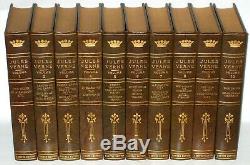
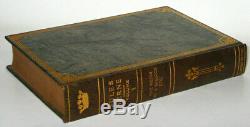
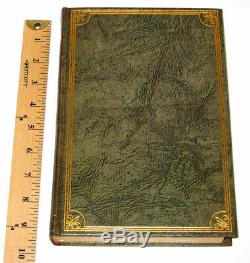
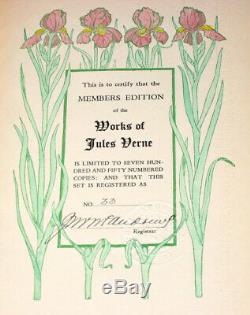
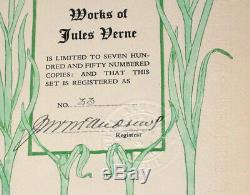

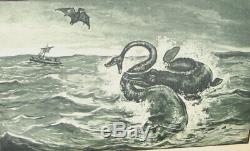
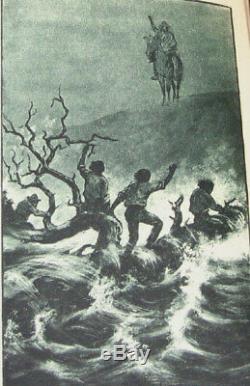
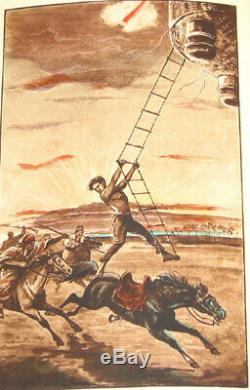
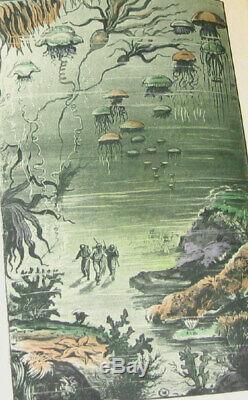
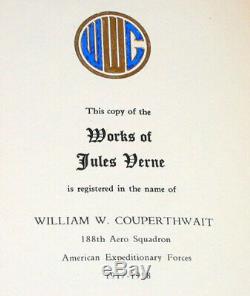
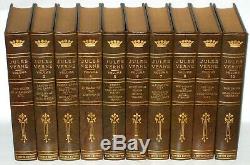


THE COMPLETE WORKS OF JULES VERNE! In MINT+ & UNREAD condition. This is the FIRST COLLECTED EDITION of Jules Verne's Works printed in English! There was a later 15 volume edition printed in 1911 by Vincent Park & Co New York. This is the 10 volume edition printed by National Alumni, with the blindstamp limitation seal dated 1904, as visible in the pictures.
This set is unobtainable in this condition. Sets of Verne are already impossible to find, let alone so well preserved. Printed during Verne's lifetime.
He died one year later, in 1905. This set is complete in 10 volumes. There was a later 15 volume edition printed in 1911 by Vincent Park & Co New York, in which the limitation page states in Fifteen Volumes. This is the ten volume edition of 1904, printed by National Alumni, with the blindstamp dated 1904. This is the First English Edition of Jules Verne's Works. Journey to the Center of the Earth (1864). Twenty Thousand Leagues Under the Sea (1870). Around the World in Eighty Days (1873). Early sets of Jules Verne are exceedingly rare and disproportionate to his popularity. Published by National Alumni with no date on the title page, circa 1904 (the blindstamp limitation seal is dated 1904), and edited by Charles F. These are full leather bindings. Top edges gilded, other edges deckled. Limited Edition' in gilt at spine heel. Complete 10 volume set'Members Edition' limited to 750 copies. The limitation plate in Volume one is decorated with hand colored purple irises with green leaves. This is to certify that the Members Edition of The Works of Jules Verne is limited to seven hundred and fifty numbered copies: and that this set is registered as number 33.It is signed by the registrar and stamped with a raised stamp that says National Alumni, 1904. A rare and highly desirable set of Jules Verne's Works.
This will make an excellent gift! From Wikipedia, the free encyclopedia. For other uses, see Jules Verne (disambiguation). Jules Gabriel Verne 8 February 1828 Nantes. 24 March 1905 (aged 77) Amiens.
Twenty Thousand Leagues Under the Sea. Journey to the Center of the Earth. From the Earth to the Moon.
Around the World in Eighty Days. Five Weeks in a Balloon. Honorine Hebe du Fraysse de Viane (Morel) Verne. 8 February 1828 24 March 1905 was a French novelist, poet, and playwright.
Verne's collaboration with the publisher Pierre-Jules Hetzel. Led to the creation of the Voyages extraordinaires. A widely popular series of scrupulously researched adventure novels including Journey to the Center of the Earth.(1864), Twenty Thousand Leagues Under the Sea. (1870), and Around the World in Eighty Days.
Verne is generally considered a major literary author in France and most of Europe, where he has had a wide influence on the literary avant-garde. His reputation is markedly different in Anglophone regions.
Where he has often been labeled a writer of genre fiction. Largely because of the highly abridged and altered translations.
In which his novels have often been printed. Verne has been the second most-translated author in the world. Since 1979, ranking between Agatha Christie. He has sometimes been called the "Father of Science Fiction", a title that has also been given to H.Nantes from Île Feydeau, around the time of Verne's birth. Verne was born on 8 February 1828, on Île Feydeau, a small artificial island on the Loire River. Within the town of Nantes. 4 Rue Olivier-de-Clisson, the house of his maternal grandmother Dame Sophie Allotte de la Fuÿe.
His parents were Pierre Verne, an attorney originally from Provins. And Sophie Allote de la Fuÿe, a Nantes woman from a local family of navigators and shipowners, of distant Scottish descent. In 1829, the Verne family moved some hundred meters away to No.2 Quai Jean-Bart, where Verne's brother Paul was born the same year. Three sisters, Anna (1836), Mathilde (1839), and Marie (1842) would follow. In 1834, at the age of six, Verne was sent to boarding school at 5 Place du Bouffay in Nantes.
The teacher, Mme Sambin, was the widow of a naval captain who had disappeared some 30 years before. Mme Sambin often told the students that her husband was a shipwrecked castaway and that he would eventually return like Robinson Crusoe. From his desert island paradise. The theme of the Robinsonade. Would stay with Verne throughout his life and appear in many of his novels, including The Mysterious Island.
(1900), and The School for Robinsons. In 1836, Verne went on to École SaintStanislas, a Catholic school suiting the pious religious tastes of his father. Verne quickly distinguished himself in mémoire (recitation from memory), geography, Greek, Latin, and singing.In the same year, 1836, Pierre Verne bought a vacation house. At 29 Rue des Réformés in the village of Chantenay (now part of Nantes) on the Loire River. In his brief memoir "Souvenirs d'enfance et de jeunesse" ("Memories of Childhood and Youth", 1890), Verne recalled a deep fascination with the river and with the many merchant vessels. He also took vacations at Brains. In the house of his uncle Prudent Allotte, a retired shipowner, who had gone around the world and served as mayor of Brains from 1828 to 1837.
Verne took joy in playing interminable rounds of the Game of the Goose. With his uncle, and both the game and his uncle's name would be memorialized in two late novels The Will of an Eccentric. (1900) and Robur the Conqueror. Legend has it that in 1839, at the age of 11, Verne secretly procured a spot as cabin boy. Where Pierre Verne arrived just in time to catch his son and make him promise to travel "only in his imagination". It is now known that the legend is an exaggerated tale invented by Verne's first biographer, his niece Marguerite Allotte de la Füye, though it may have been inspired by a real incident. The Lycée Royal in Nantes (now the Lycée Georges-Clemenceau), where Jules Verne studied. In 1840, the Vernes moved again to a large apartment at No.6 Rue Jean-Jacques-Rousseau, where the family's youngest child, Marie, was born in 1842. In the same year Verne entered another religious school, the Petit Séminaire de Saint-Donatien, as a lay student. His unfinished novel Un prêtre en 1839 (A Priest in 1839), written in his teens and the earliest of his prose works to survive. Describes the seminary in disparaging terms.
From 1844 to 1846, Verne and his brother were enrolled in the Lycée Royal (now the Lycée Georges-Clemenceau) in Nantes. After finishing classes in rhetoric and philosophy, he took the baccalauréat.And received the grade "Fairly good" on 29 July 1846. By 1847, when Verne was 19, he had taken seriously to writing long works in the style of Victor Hugo.
Beginning Un prêtre en 1839 and seeing two verse tragedies, Alexandre VI and La Conspiration des poudres (The Gunpowder Plot), to completion. In 1847, Verne's father sent him to Paris, primarily to begin his studies in law school.
And secondarily (according to family legend) to distance him temporarily from Nantes. His cousin Caroline, with whom he was in love, was married on 27 April 1847, to Émile Dezaunay, a man of 40, with whom she would have five children. While in Nantes, he met Rose Herminie Arnaud Grossetière, a young woman one year his senior, and fell intensely in love with her. He wrote and dedicated some 30 poems to her, including "La Fille de l'air" ("The Daughter of Air"), which describes her as "blonde and enchanting / winged and transparent". His passion seems to have been reciprocated, at least for a short time.But Grossetière's parents frowned upon the idea of their daughter marrying a young student of uncertain future. They married her instead to Armand Terrien de la Haye, a rich landowner 10 years her senior, on 19 July 1848. The sudden marriage sent Verne into deep frustration. He wrote a hallucinatory letter to his mother, apparently composed in a state of half-drunkenness, in which under pretext of a dream he described his misery.
This requited but aborted love affair seems to have permanently marked the author and his work, and his novels include a significant number of young women married against their will Gérande in Master Zacharius. (1854), Sava in Mathias Sandorf. (1885), Ellen in A Floating City., to such an extent that the scholar Christian Chelebourg attributed the recurring theme to a "Herminie complex". The incident also led Verne to bear a grudge against his birthplace and Nantes society, which he criticized in his poem "La sixième ville de France" ("The Sixth City of France"). In July 1848, Verne left Nantes again for Paris, where his father intended him to finish law studies and take up law as a profession. He obtained permission from his father to rent a furnished apartment at 24 Rue de l'Ancienne-Comédie, which he shared with Édouard Bonamy, another student of Nantes origin.
On his 1847 Paris visit, Verne had stayed at 2 Rue Thérèse, the house of his aunt Charuel, on the Butte Saint-Roch. Verne arrived in Paris during a time of political upheaval: the French Revolution of 1848. In February, Louis Philippe I. Had been overthrown and had fled; on 24 February, a provisional government of the French Second Republic.
Took power, but political demonstrations continued, and social tension remained. In June, barricades went up in Paris, and the government sent Louis-Eugène Cavaignac. Verne entered the city shortly before the election of Louis-Napoléon Bonaparte.As the first president of the Republic, a state of affairs that would last until the French coup of 1851. In a letter to his family, Verne described the bombarded state of the city after the recent June Days uprising.
But assured them that the anniversary of Bastille Day. Had gone by without any significant conflict. Verne used his family connections to make an entrance into Paris society. His uncle Francisque de Chatêaubourg introduced him into literary salons. And Verne particularly frequented those of Mme de Barrère, a friend of his mother's.While continuing his law studies, he fed his passion for the theatre, writing numerous plays. Verne later recalled: I was greatly under the influence of Victor Hugo. Indeed, very excited by reading and re-reading his works.
At that time I could have recited by heart whole pages of Notre Dame de Paris. But it was his dramatic work that most influenced me. Another source of creative stimulation came from a neighbor: living on the same floor in the Rue de l'Ancienne-Comédie apartment house was a young composer, Aristide Hignard. With whom Verne soon became good friends, and Verne wrote several texts for Hignard to set as chansons. During this period, Verne's letters to his parents primarily focused on expenses and on a suddenly appearing series of violent stomach cramps.
The first of many he would suffer from during his life. Modern scholars have hypothesized that he suffered from colitis.
Verne believed the illness to have been inherited from his mother's side. Rumors of an outbreak of cholera. In March 1849 exacerbated these medical concerns.
Yet another health problem would strike in 1851 when Verne suffered the first of four attacks of facial paralysis. These attacks, rather than being psychosomatic. Were due to an inflammation in the middle ear. Though this cause remained unknown to Verne during his life.
In the same year, Verne was required to enlist in the French military. Process spared him, to his great relief.He wrote to his father: You should already know, dear papa, what I think of the military life, and of these domestic servants in livery. You have to abandon all dignity to perform such functions.
Verne's strong antiwar sentiments, to the dismay of his father, would remain steadfast throughout his life. Though writing profusely and frequenting the salons, Verne diligently pursued his law studies and graduated with a licence en droit in January 1851. Thanks to his visits to salons, Verne came into contact in 1849 with Alexandre Dumas. Through the mutual acquaintance of a celebrated chirologist. Of the time, the Chevalier d'Arpentigny.
Verne became close friends with Dumas' son, Alexandre Dumas, fils. And showed him a manuscript for a stage comedy, Les Pailles rompues (The Broken Straws). The two young men revised the play together, and Dumas, through arrangements with his father, had it produced by the Opéra-National.In Paris, opening on 12 June 1850. Cover of an 185455 issue of Musée des familles. In 1851, Verne met with a fellow writer from Nantes, Pierre-Michel-François Chevalier. (known as "Pitre-Chevalier"), the editor-in-chief of the magazine Musée des familles. Pitre-Chevalier was looking for articles about geography, history, science, and technology, and was keen to make sure that the educational component would be made accessible to large popular audiences using a straightforward prose style or an engaging fictional story.
Verne, with his delight in diligent research, especially in geography, was a natural for the job. Verne first offered him a short historical. The First Ships of the Mexican Navy. , written in the style of James Fenimore Cooper. Whose novels had deeply influenced him.
Pitre-Chevalier published it in July 1851, and in the same year published a second short story, A Voyage in a Balloon. The latter story, with its combination of adventurous narrative, travel themes, and detailed historical research, would later be described by Verne as "the first indication of the line of novel that I was destined to follow". Dumas fils put Verne in contact with Jules Seveste, a stage director who had taken over the directorship of the Théâtre-Historique and renamed it the Théâtre Lyrique. Seveste offered Verne the job of secretary of the theatre, with little or no salary attached.
Verne accepted, using the opportunity to write and produce several comic operas written in collaboration with Hignard and the prolific librettist Michel Carré. To celebrate his employment at the Théâtre Lyrique, Verne joined with ten friends to found a bachelors' dining club, the Onze-sans-femme (Eleven Bachelors). For some time, Verne's father pressed him to abandon his writing and begin a business as a lawyer. However, Verne argued in his letters that he could only find success in literature.
The pressure to plan for a secure future in law reached its climax in January 1852, when his father offered Verne his own Nantes law practice. Meanwhile, Verne was spending much time at the Bibliothèque nationale de France. Conducting research for his stories and feeding his passion for science and recent discoveries, especially in geography.It was in this period that Verne met the illustrious geographer and explorer Jacques Arago. Who continued to travel extensively despite his blindness (he had lost his sight completely in 1837). The two men became good friends, and Arago's innovative and witty accounts of his travels led Verne toward a newly developing genre of literature: that of travel writing.
In 1852, two new pieces from Verne appeared in the Musée des familles : Martin Paz. , a novella set in Lima, which Verne wrote in 1851 and published 10 July through 11 August 1852, and Les Châteaux en Californie, ou, Pierre qui roule n'amasse pas mousse (The Castles in California, or, A Rolling Stone Gathers No Moss), a one-act comedy full of racy double entendres. In April and May 1854, the magazine published Verne's short story Master Zacharius. Like fantasy featuring a sharp condemnation of scientific hubris.
Followed soon afterward by A Winter Amid the Ice. , a polar adventure story whose themes closely anticipated many of Verne's novels. The Musée also published some nonfiction popular science. Articles which, though unsigned, are generally attributed to Verne. Verne's work for the magazine was cut short in 1856 when he had a serious quarrel with Pitre-Chevalier and refused to continue contributing (a refusal he would maintain until 1863, when Pitre-Chevalier died, and the magazine went to new editorship). While writing stories and articles for Pitre-Chevalier, Verne began to form the idea of inventing a new kind of novel, a Roman de la Science (novel of science), which would allow him to incorporate large amounts of the factual information he so enjoyed researching in the Bibliothèque. He is said to have discussed the project with the elder Alexandre Dumas, who had tried something similar with an unfinished novel, Isaac Laquedem , and who enthusiastically encouraged Verne's project. At the end of 1854, another outbreak of cholera led to the death of Jules Seveste, Verne's employer at the Théâtre Lyrique and by then a good friend. Though his contract only held him to a further year of service, Verne remained connected to the theatre for several years after Seveste's death, seeing additional productions to fruition. He also continued to write plays and musical comedies, most of which were not performed. In May 1856, Verne traveled to Amiens. To be the best man.At the wedding of a Nantes friend, Auguste Lelarge, to an Amiens woman named Aimée du Fraysse de Viane. Verne, invited to stay with the bride's family, took to them warmly, befriending the entire household and finding himself increasingly attracted to the bride's sister, Honorine de Viane Morel, a widow aged 26 with two young children. Hoping to find a secure source of income, as well as a chance to court Morel in earnest, he jumped at her brother's offer to go into business with a broker. Verne's father was initially dubious but gave in to his son's requests for approval in November 1856. With his financial situation finally looking promising, Verne won the favor of Morel and her family, and the couple were married on 10 January 1857.
Verne plunged into his new business obligations, leaving his work at the Théâtre Lyrique and taking up a full-time job as an agent de change. Where he became the associate of the broker Fernand Eggly. Verne woke up early each morning so that he would have time to write, before going to the Bourse for the day's work; in the rest of his spare time, he continued to consort with the Onze-Sans-Femme club (all eleven of its "bachelors" had by this time gotten married). He also continued to frequent the Bibliothèque to do scientific and historical research, much of which he copied onto notecards for future usea system he would continue for the rest of his life.According to the recollections of a colleague, Verne "did better in repartee than in business". In July 1858, Verne and Aristide Hignard seized an opportunity offered by Hignard's brother: a sea voyage, at no charge, from Bordeaux. The journey, Verne's first trip outside France, deeply impressed him, and upon his return to Paris he fictionalized his recollections to form the backbone of a semi-autobiographical novel, Backwards to Britain.
(written in the autumn and winter of 18591860 and not published until 1989). A second complementary voyage in 1861 took Hignard and Verne to Stockholm. From where they traveled to Christiania. Verne left Hignard in Denmark to return in haste to Paris, but missed the birth on 3 August 1861 of his only biological son, Michel.
Meanwhile, Verne continued work on the idea of a Roman de la Science , which he developed in a rough draft inspired, according to his recollections, by his "love for maps and the great explorers of the world". It took shape as a story of travel across Africa and would eventually become his first published novel, Five Weeks in a Balloon.In 1862, through their mutual acquaintance Alfred de Bréhat, Verne came into contact with the publisher Pierre-Jules Hetzel. And submitted to him the manuscript of his developing novel, then called Voyage en Ballon.
Hetzel, already the publisher of Balzac. And other well-known authors, had long been planning to launch a high-quality family magazine in which entertaining fiction would combine with scientific education. He saw Verne, with his demonstrated inclination toward scrupulously researched adventure stories, as an ideal contributor for such a magazine, and accepted the novel, giving Verne suggestions for improvement.It was published by Hetzel on 31 January 1863. Verne, finding both a steady salary and a sure outlet for writing at last, accepted immediately. For the rest of his lifetime, most of his novels would be serialized in Hetzel's Magasin before their appearance in book form, beginning with his second novel for Hetzel, The Adventures of Captain Hatteras.
A Hetzel edition of Verne's The Adventures of Captain Hatteras. (cover style "Aux deux éléphants"). When The Adventures of Captain Hatteras was published in book form in 1866, Hetzel publicly announced his literary and educational ambitions for Verne's novels by saying in a preface that Verne's works would form a novel sequence.
(Extraordinary Voyages or Extraordinary Journeys), and that Verne's aim was "to outline all the geographical, geological, physical, and astronomical knowledge amassed by modern science and to recount, in an entertaining and picturesque format that is his own, the history of the universe". Late in life, Verne confirmed that this commission had become the running theme of his novels: My object has been to depict the earth, and not the earth alone, but the universe And I have tried at the same time to realize a very high ideal of beauty of style.
It is said that there can't be any style in a novel of adventure, but it isn't true. However, he also noted that the project was extremely ambitious: Yes! But the Earth is very large, and life is very short! In order to leave a completed work behind, one would need to live to be at least 100 years old! Hetzel influenced many of Verne's novels directly, especially in the first few years of their collaboration, for Verne was initially so happy to find a publisher that he agreed to almost all of the changes Hetzel suggested.
For example, when Hetzel disapproved of the original climax of Captain Hatteras , including the death of the title character, Verne wrote an entirely new conclusion in which Hatteras survived. Hetzel also rejected Verne's next submission, Paris in the Twentieth Century. Believing its pessimistic view of the future and its condemnation of technological progress were too subversive for a family magazine. For some time after Verne's death, was finally published in 1994.
The relationship between publisher and writer changed significantly around 1869 when Verne and Hetzel were brought into conflict over the manuscript for Twenty Thousand Leagues Under the Sea. Verne had initially conceived of the submariner Captain Nemo. As a Polish scientist whose acts of vengeance were directed against the Russians who had killed his family during the January uprising. Hetzel, not wanting to alienate the lucrative Russian market for Verne's books, demanded that Nemo be made an enemy of the slave trade.
A situation that would make him an unambiguous hero. Verne, after fighting vehemently against the change, finally invented a compromise in which Nemo's past is left mysterious.After this disagreement, Verne became notably cooler in his dealings with Hetzel, taking suggestions into consideration but often rejecting them outright. From that point, Verne published two or more volumes a year. The most successful of these are: Voyage au centre de la Terre Journey to the Center of the Earth.
1864; De la Terre à la Lune From the Earth to the Moon. 1865; Vingt mille lieues sous les mers Twenty Thousand Leagues Under the Sea. 1869; and Le tour du monde en quatre-vingts jours Around the World in Eighty Days. , which first appeared in Le Temps in 1872. Verne could now live on his writings. But most of his wealth came from the stage adaptations of Le tour du monde en quatre-vingts jours (1874) and Michel Strogoff (1876), which he wrote with Adolphe d'Ennery. Sketch by Verne of the Saint-Michel.On board the Saint-Michel III , he sailed around Europe. After his first novel, most of his stories were first serialised in the Magazine d'Éducation et de Récréation , a Hetzel biweekly publication, before being published in book form. His brother Paul contributed to 40th French climbing of the Mont-Blanc and a collection of short stories Doctor Ox in 1874.
Verne became wealthy and famous. Meanwhile, Michel Verne married an actress against his father's wishes, had two children by an underage mistress and buried himself in debts.The relationship between father and son improved as Michel grew older. Jules Verne and Madame Verne ca. Though he was raised Catholic, Verne became a deist.
In his later years, from about 1870 onward. Some scholars believe his deist philosophy is reflected in his novels, as they often involve the notion of God or divine providence. But rarely mention the concept of Christ. On 9 March 1886, as Verne was coming home, his twenty-six-year-old nephew, Gaston, shot at him twice with a pistol. The first bullet missed, but the second one entered Verne's left leg, giving him a permanent limp that could not be overcome. This incident was hushed up in the media, but Gaston spent the rest of his life in a mental asylum. After the death of both his mother and Hetzel, Jules Verne began publishing darker works.In 1888, Verne entered politics and was elected town councilor of Amiens. Where he championed several improvements and served for fifteen years. Verne was made a Chevalier de la Légion d'honneur. He was promoted to an Officier de la Légion d'honneur in 1892. On 24 March 1905, while ill with diabetes.
Verne died at his home in Amiens. 44 Boulevard Longueville (now Boulevard Jules-Verne). His son, Michel Verne, oversaw publication of the novels Invasion of the Sea and The Lighthouse at the End of the World. The Voyages extraordinaires series continued for several years afterwards at the same rate of two volumes a year. It was later discovered that Michel Verne had made extensive changes in these stories, and the original versions were eventually published at the end of the 20th century by the Jules Verne Society (Société Jules Verne). In 1919, Michel Verne published The Barsac Mission.L'Étonnante Aventure de la Mission Barsac , which original drafts contained references to Esperanto. Language about which his father had great interest. In 1989, Verne's great-grandson discovered his ancestor's as yet unpublished novel Paris in the Twentieth Century.
Which was subsequently published in 1994. Jules Verne on his deathbed. Verne's funeral procession, headed by his son and grandson. Verne's tomb in Amiens.
See also: Jules Verne bibliography. An 1889 Hetzel poster advertising Verne's works. Jules Verne novels: The Carpathian Castle. Verne's largest body of work is the Voyages extraordinaires.
Series, which includes all of his novels except for the two rejected manuscripts Paris in the Twentieth Century. (published posthumously in 1994 and 1989, respectively) and for projects left unfinished at his death (many of which would be posthumously adapted or rewritten for publication by his son Michel). Verne also wrote many plays, poems, song texts, operetta libretti, and short stories, as well as a variety of essays and miscellaneous non-fiction.
Under Hetzel, Verne was enthusiastically received in France by writers and scientists alike, with George Sand. Several notable contemporary figures, from the geographer Vivien de Saint-Martin to the critic Jules Claretie. Spoke highly of Verne and his works in critical and biographical notes. However, Verne's growing popularity among readers and playgoers (due especially to the highly successful stage version of Around the World in Eighty Days) led to a gradual change in his literary reputation. As the novels and stage productions continued to sell, many contemporary critics felt that Verne's status as a commercially popular author meant he could only be seen as a mere genre-based storyteller, rather than a serious author worthy of academic study. This denial of formal literary status took various forms, including dismissive criticism by such writers as Émile Zola.And the lack of nomination to Verne for membership in the Académie Française. And was recognized by Verne himself, who said in a late interview: The great regret of my life is that I have never taken any place in French literature. To Verne, who considered himself "a man of letters and an artist, living in the pursuit of the ideal". This critical dismissal on the basis of literary ideology could only be seen as the ultimate snub. This bifurcation of Verne as a popular genre writer but a critical persona non grata.
Continued after his death, with early biographies (including one by Verne's own niece, Marguerite Allotte de la Fuÿe) focusing on error-filled and embroidered hagiography. Of Verne as a popular figure rather than on Verne's actual working methods or his output. Meanwhile, sales of Verne's novels in their original unabridged versions dropped markedly even in Verne's home country, with abridged versions aimed directly at children taking their place.
However, the decades after Verne's death also saw the rise in France of the "Jules Verne cult", a steadily growing group of scholars and young writers who took Verne's works seriously as literature and willingly noted his influence on their own pioneering works. Some of the cult founded the Société Jules Verne, the first academic society for Verne scholars; many others became highly respected avant garde. Literary figures in their own right. Their praise and analyses, emphasizing Verne's stylistic innovations and enduring literary themes, proved highly influential for literary studies to come. In the 1960s and 1970s, thanks in large part to a sustained wave of serious literary study from well-known French scholars and writers, Verne's reputation skyrocketed in France.
Seminal essay "Nautilus et Bateau Ivre" The Nautilus. Was influential in its exegesis.Of the Voyages extraordinares as a purely literary text, while book-length studies by such figures as Marcel Moré and Jean Chesneaux considered Verne from a multitude of thematic vantage points. French literary journals devoted entire issues to Verne and his work, with essays by such imposing literary figures as Michel Butor.
The wave reached its climax in Verne's sesquicentennial. Year 1978, when he was made the subject of an academic colloquium at the Centre culturel international de Cerisy-la-Salle. And Journey to the Center of the Earth. Was accepted for the French university system's Agrégation. Since these events, Verne has been consistently recognized in Europe as a legitimate member of the French literary canon, with academic studies and new publications steadily continuing. Verne's reputation in English-speaking countries has been considerably slower in changing. Throughout the 20th century, most Anglophone scholars dismissed Verne as a genre writer for children and a naïve proponent of science and technology (despite strong evidence to the contrary on both counts), thus finding him more interesting as a technological "prophet" or as a subject of comparison to English-language writers such as Edgar Allan Poe. Than as a topic of literary study in his own right.This narrow view of Verne has undoubtedly been influenced by the poor-quality English translations. And very loosely adapted Hollywood film.
Versions through which most American and British readers have discovered Verne. However, since the mid-1980s a considerable number of serious English-language studies and translations have appeared, suggesting that a rehabilitation of Verne's Anglophone reputation may currently be underway. An early edition of the notorious Griffith & Farran adaptation of Journey to the Center of the Earth. Translation of Verne into English began in 1852, when Verne's short story A Voyage in a Balloon. (1851) was published in the American journal Sartain's Union Magazine of Literature and Art.
In a translation by Anne T. Translation of his novels began in 1869 with William Lackland's translation of Five Weeks in a Balloon. And continued steadily throughout Verne's lifetime, with publishers and hired translators often working in great haste to rush his most lucrative titles into English-language print. Unlike Hetzel, who targeted all ages with his publishing strategies for the Voyages extraordinaires , the British and American publishers of Verne chose to market his books almost exclusively to young audiences; this business move, with its implication that Verne could be treated purely as a children's author, had a long-lasting effect on Verne's reputation in English-speaking countries. These early English-language translations have been widely criticized for their extensive textual omissions, errors, and alterations, and are not considered adequate representations of Verne's actual novels.The British writer Adam Roberts. In an essay for The Guardian. Titled "Jules Verne deserves a better translation service", commented: I'd always liked reading Jules Verne and I've read most of his novels; but it wasn't until recently that I really understood I hadn't been reading Jules Verne at all.... It's a bizarre situation for a world-famous writer to be in.
Indeed, I can't think of a major writer who has been so poorly served by translation. Similarly, the American novelist Michael Crichton. Since 1965, a considerable number of more accurate English translations of Verne have appeared. However, the highly criticized older translations continue to be republished, due to their public domain. Status and in many cases their easy availability in online sources.Caricature of Verne with fantastic sea life (1884). The relationship between Verne's Voyages extraordinaires and the literary genre science fiction is a complex one.
Is frequently cited as one of the founders of the genre, and his profound influence on its development is indisputable; however, many earlier writers, such as Lucian of Samosata. Have also been cited as creators of science fiction, an unavoidable ambiguity arising from the vague definition and history of the genre. A primary issue at the heart of the dispute is the question of whether Verne's works count as science fiction to begin with. Claimed that Verne "never wrote a single sentence of scientific-marvelous".
Verne himself argued repeatedly in interviews that his novels were not meant to be read as scientific, saying "I have invented nothing". His own goal was rather to "depict the earth [and] at the same time to realize a very high ideal of beauty of style". As he pointed out in an example. Closely related to Verne's science-fiction reputation is the often-repeated claim that he is a prophet. Of scientific progress, and that many of his novels involve elements of technology that were fantastic for his day but later became commonplace.These claims have a long history, especially in America, but the modern scholarly consensus is that such claims of prophecy are heavily exaggerated. In a 1961 article critical of Twenty Thousand Leagues Under the Sea. S scientific accuracy, Theodore L.
Speculated that Verne's storytelling skill and readers misremembering a book they read as children caused people to remember things from it that are not there. The impression that the novel contains valid scientific prediction seems to grow as the years roll by. As with science fiction, Verne himself flatly denied that he was a futuristic prophet, saying that any connection between scientific developments and his work was "mere coincidence" and attributing his indisputable scientific accuracy to his extensive research: even before I began writing stories, I always took numerous notes out of every book, newspaper, magazine, or scientific report that I came across.Main article: Cultural influence of Jules Verne. Monument to Verne in Redondela. Verne's novels have had a wide influence on both literary and scientific works; writers known to have been influenced by Verne include Marcel Aymé. While scientists and explorers who acknowledged Verne's inspiration have included Richard E. He is credited with helping inspire the steampunk.
Genre, a literary and social movement that glamorizes science fiction based on 19th-century technology. Summed up Verne's influence on literature and science the world over by saying: We are all, in one way or another, the children of Jules Verne. The item "LEATHER SetWORKS of JULES VERNE! RARE 1904" is in sale since Tuesday, July 2, 2019. This item is in the category "Books\Antiquarian & Collectible".books" and is located in Moab, Utah. This item can be shipped worldwide.
- Year Printed: 1904
- Topic: Classics
- Binding: Leather
- Author: Jules Verne
- Subject: Literature & Fiction
- Original/Facsimile: Original
- Language: English
- Publisher: National Alumni
- Place of Publication: New York
- Special Attributes: 1st Edition


